英语 清明上河图
中英对照Riverside Scene at Qingming Festival清明上河图
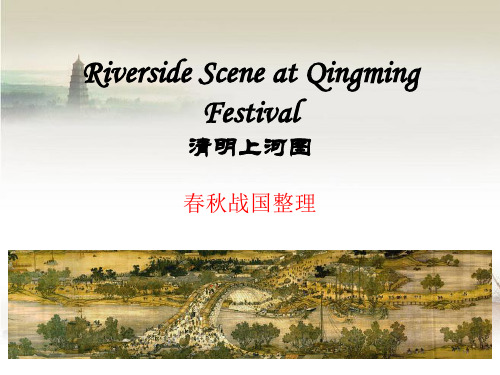
➢It is an important historical reference material for the study of the city then as well as the life its residents rich and poor.
alsoknownitsgeometricallyaccurateimagesvarietynaturalelementsarchitecturesboatsbridgesmarketplacestorespeople清明上河图也因为画中各种自然元素建筑船艇以及小桥集市店铺还有人物风景等在空间上精确合理的布局而闻名于geometrically意思是几何学上的geometricallyaccurateimages表面译为几何上精确的图片根据文中的意境应该是各个元素在空间上合理而准确的布局
注释: expression n. 表现,表示,表达;表情,脸色,态度,腔调,声调; 式,符号;词句,语句,措辞,说法
词根:express adj. expressive 表现的;有表现力的;表达…的 expressionless 无表情的;呆板的 expressible 可表现的;可榨出的 adv. expressly 清楚地,明显地;特别地,专门地 expressively 表现地;意味深长地;表示地 n. expression 表达,表示;表情;表现力;措辞 expressionism 表现主义 expressiveness 善于表现;表情丰富 expressage 快递业务;速递费
清明上河图推荐英语作文高考

清明上河图推荐英语作文高考English:The Qingming Shanghe Tu, also known as Along the River During the Qingming Festival, is a famous painting from the Song Dynasty that captures the hustle and bustle of daily life in Bianjing, the capital of the Northern Song Dynasty. The painting is renowned for its intricate and detailed depiction of the cityscape, showcasing a wide array of activities and scenes such as bustling markets, busy streets, bridges, boats, and people from all walks of life. Each section of the painting tells a unique story, offering a glimpse into the daily lives, customs, and social hierarchy of the time. The exquisite craftsmanship and attention to detail in the painting make it a valuable cultural treasure that provides valuable insights into Chinese history, society, and art during the Song Dynasty.Translated content:清明上河图,又称《清明上河图》,是一幅著名的宋代绘画作品,捕捉了北宋汴京城日常生活的繁忙景象。
介绍清明上河图英语作文100字
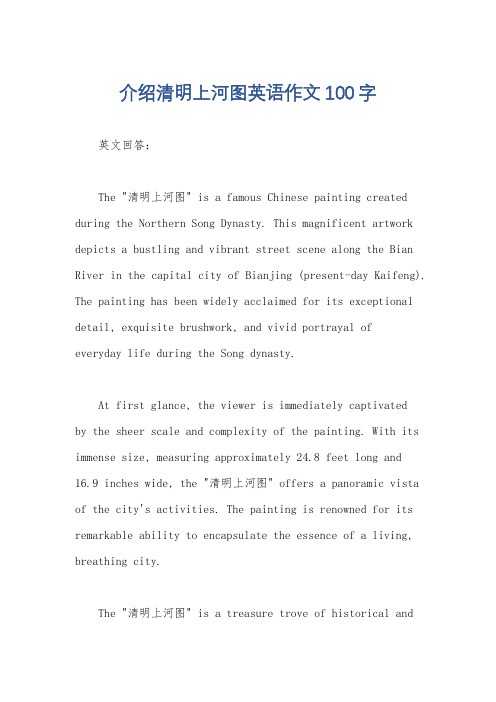
介绍清明上河图英语作文100字英文回答:The "清明上河图" is a famous Chinese painting created during the Northern Song Dynasty. This magnificent artwork depicts a bustling and vibrant street scene along the Bian River in the capital city of Bianjing (present-day Kaifeng). The painting has been widely acclaimed for its exceptional detail, exquisite brushwork, and vivid portrayal ofeveryday life during the Song dynasty.At first glance, the viewer is immediately captivatedby the sheer scale and complexity of the painting. With its immense size, measuring approximately 24.8 feet long and 16.9 inches wide, the "清明上河图" offers a panoramic vista of the city's activities. The painting is renowned for its remarkable ability to encapsulate the essence of a living, breathing city.The "清明上河图" is a treasure trove of historical andcultural information, granting us a glimpse into thevibrant customs, traditions, and daily routines prevalent in Song dynasty China. The painting meticulously depicts various aspects of urban life, from bustling marketplaces and crowded streets to stately mansions and imperial palaces. One can observe the diverse social strata interacting and going about their daily lives, from merchants hawking their wares to officials parading through the streets.This meticulous level of detail extends to theintricate depictions of architecture, clothing, transportation, and even the flora and fauna within the painting. Each building, bridge, and boat is rendered with precision, providing valuable insights into the architectural styles and technological advancements of the era. The painting is also notable for its portrayal of various forms of entertainment, including acrobats, musicians, and street performers, showcasing the rich cultural tapestry of the Song dynasty.The "清明上河图" has been the subject of extensivestudy and analysis, with scholars and art historians dedicating years to unraveling its intricate symbolism and uncovering hidden meanings. The painting has been interpreted as a celebration of the economic prosperity and cultural achievements of the Song dynasty, while also offering a critique of the social inequality and moral decay that existed during this period.The enduring legacy of the "清明上河图" is evident in its profound influence on Chinese art and culture. The painting has served as a source of inspiration for countless artists throughout history, influencing the development of various painting techniques and styles. It has also been reproduced extensively in various forms, including prints, scrolls, and even tapestries, making it one of the most recognizable and celebrated works of Chinese art.In conclusion, the "清明上河图" is a masterpiece of Chinese painting that stands as a testament to the artistic brilliance and cultural heritage of the Song dynasty. With its exquisite detail, vibrant colors, and profoundsymbolism, this painting invites viewers to explore the complexities and wonders of an ancient civilization. As one of the most iconic works of Chinese art, the "清明上河图" continues to fascinate and inspire audiences around the world, offering a timeless glimpse into the rich historical and cultural tapestry of China.中文回答:清明上河图。
作文介绍清明上河图英文

作文介绍清明上河图英文The Qingming Festival, also known as Tomb Sweeping Day, is a traditional Chinese festival that falls on the 15th day after the Spring Equinox. It is a time for people to pay their respects to their ancestors and loved ones who have passed away. One of the most famous cultural artifacts associated with the Qingming Festival is the painting known as the "Qingming Shanghe Tu" (清明上河图), or "Along the River During the Qingming Festival."The "Qingming Shanghe Tu" is a masterpiece of Chinese painting that was created during the Song Dynasty (960-1279 AD) by artist Zhang Zeduan. The painting is a panoramic scroll that measures 24.8 cm in height and 5.29 meters in length. It depicts the bustling scene of a city during the Qingming Festival, with hundreds of people engaged in various activities along the banks of the Bian River.The painting is divided into three main sections. The first section shows the countryside outside the city, withfarmers working in the fields and people traveling on foot or horseback. The second section shows the city itself, with its busy streets, bustling markets, and elegant buildings. The third section shows the river, with boats and ships of various sizes and shapes sailing up and down the waterway.One of the most remarkable things about the "Qingming Shanghe Tu" is its attention to detail. Every aspect of the painting, from the architecture of the buildings to the clothing of the people, is rendered with incredible precision and accuracy. The painting is a testament to the artistic skill and technical mastery of its creator.The "Qingming Shanghe Tu" is not only a work of art, but also a valuable historical document. It provides avivid and detailed glimpse into the daily life and customs of the people of the Song Dynasty. It is a testament to the rich cultural heritage of China and a source of inspiration for artists and historians around the world.In conclusion, the "Qingming Shanghe Tu" is amasterpiece of Chinese painting that captures the spirit and essence of the Qingming Festival. Its intricate details and vivid scenes provide a window into the past and a source of inspiration for the future. It is a cultural treasure that deserves to be celebrated and appreciated for generations to come.。
大学英语四级-115

大学英语四级-115(总分:100.00,做题时间:90分钟)一、汉译英(总题数:5,分数:100.00)1.清明上河图《清明上河图》 ( Along the River during the Qingming Festival )是中国名画之一。
它为北宋 (the Northern Song Dynasty)画家张择端所作,现收藏于故宫物院 (the Palace Museum)。
《清明上河图》宽25.5厘米,长525厘米。
画卷里,画家描绘了北宋清明时节都城的自然风光和人们的日常生活。
《清明上河图》内容丰富,绘有大量的人物、树木、动物、车辆、建筑和船只。
因其具有很高的历史价值和艺术价值,《清明上河图》被视为国宝。
(分数:20.00)__________________________________________________________________________________________ 正确答案:()解析:Along the River during the Qingming Festival is one of Chinese famous paintings. Painted by Zhang Zeduan, a painter in the Northern Song Dynasty, this painting is now kept in the Palace Museum. The painting is 25.5 centimeters wide and 525 centimeters long. In the painting, the painter had captured the natural scenes and daily life of people of the capital during the Qingming Festivial in the Northern Song Dynasty. The painting is rich in content with a large number of humans, trees, animals, carriages, buildings and boats. The painting is considered as a national treasure for its very high historic and artistic values. [解析] 1.第2句中的“它为……所作,现收藏于……”如果逐字对译为it was painted by...and it is kept in...则稍显生硬、不够顺畅。
大学英语作文介绍清明上河图
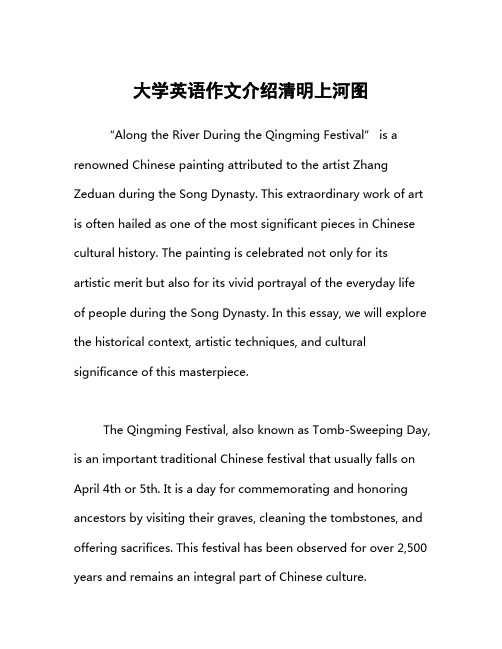
大学英语作文介绍清明上河图“Along the River During the Qingming Festival” is a renowned Chinese painting attributed to the artist Zhang Zeduan during the Song Dynasty. This extraordinary work of art is often hailed as one of the most significant pieces in Chinese cultural history. The painting is celebrated not only for its artistic merit but also for its vivid portrayal of the everyday life of people during the Song Dynasty. In this essay, we will explore the historical context, artistic techniques, and cultural significance of this masterpiece.The Qingming Festival, also known as Tomb-Sweeping Day, is an important traditional Chinese festival that usually falls on April 4th or 5th. It is a day for commemorating and honoring ancestors by visiting their graves, cleaning the tombstones, and offering sacrifices. This festival has been observed for over 2,500 years and remains an integral part of Chinese culture.“Along the River During the Qingming Festival” captures the essence of this festival in a grand and detailed panorama. The painting, measuring approximately 25.5 cm in height and 525 cm in length, is a handscroll that depicts the bustling scene of the Bianjing city (modern-day Kaifeng) during the Northern Song Dynasty. Through meticulous attention to detail, Zhang Zeduan presents a vivid snapshot of the era, providing valuable insights into the socio-economic conditions, architectural styles, and customs of the time.Zhang Zeduan’s “Along the River During the Qingming Festival” is renowned for its intricate de tail and realistic portrayal of urban and rural life. The painting employs a combination of traditional Chinese painting techniques, including fine line drawing and meticulous coloring. The use of perspective in the painting is particularly noteworthy. Unlike Western perspective, which typically employs a single vanishing point, Zhang Zeduan uses a continuous perspective to guidethe viewer’s eye through the various scenes depicted in the scroll.The painting can be divided into three sections: the rural area, the river, and the urban area. In the rural section, the artist depicts serene countryside scenes with farmers working in the fields, livestock grazing, and villagers going about their daily chores. This transitions seamlessly into the river section, where a variety of boats and ferries are shown navigating the waters, indicating the significance of river transport and trade. The urban section is the most vibrant part of the painting, showcasing a bustling marketplace, streets filled with vendors, shops, teahouses, and a diverse array of people engaged in various activities.“Along the River During the Qingming Festival” is more than just a painting; it is a window into the past. It provides a comprehensive overview of the lifestyle and culture during the Northern Song Dynasty. The painting highlights the economicprosperity of the time, as evidenced by the bustling markets and the variety of goods being traded. It also reflects the social structure and the coexistence of different classes and occupations within the city.One of the most striking features of the painting is its depiction of technology and innovation. For instance, the Rainbow Bridge, a prominent structure in the painting, showcases the architectural ingenuity of the period. The bridge’s u nique design, with its high arch and no visible means of support, reflects advanced engineering skills. Additionally, the variety of boats and the presence of waterwheels indicate the importance of water management and transportation in the Song Dynasty.The painting also emphasizes the cultural diversity and tolerance of the time. People from different social backgrounds, including merchants, scholars, laborers, and officials, are alldepicted interacting harmoniously. This suggests a society that, while hierarchical, was also inclusive and dynamic.Over the centuries, “Along the River During the Qingming Festival” has inspired countless artists, scholars, and historians. The painting has been copied and reproduced in various forms, including woodblock prints, embroideries, and even modern digital recreations. Each version offers a unique interpretation, further enriching the legacy of the original work.In contemporary times, the painting continues to be a source of national pride and cultural identity for China. It is frequently exhibited in museums and is often included in discussions about Chinese art and history. The meticulous detail and historical accuracy of the painting make it a valuable educational tool, helping people to understand and appreciate the richness of China’s cultural heritage.“Along the River During the Qingming Festival” is a masterpiece that transcends time. Zhang Zeduan’s remarkable ability to capture the essence of a bustling city during the Qingming Festival provides a timeless snapshot of the Song Dynasty. The painting’s intricate details, historical accuracy, and cultural significance make it a vital piece of Chinese art history. It serves as a testament to the ingenuity, creativity, and cultural richness of ancient China, offering a glimpse into a world that, while long past, continues to resonate with contemporary audiences. Through this extraordinary work, we are reminded of the enduring power of art to capture and preserve the human experience.。
向外国人介绍清明上河图的英语作文
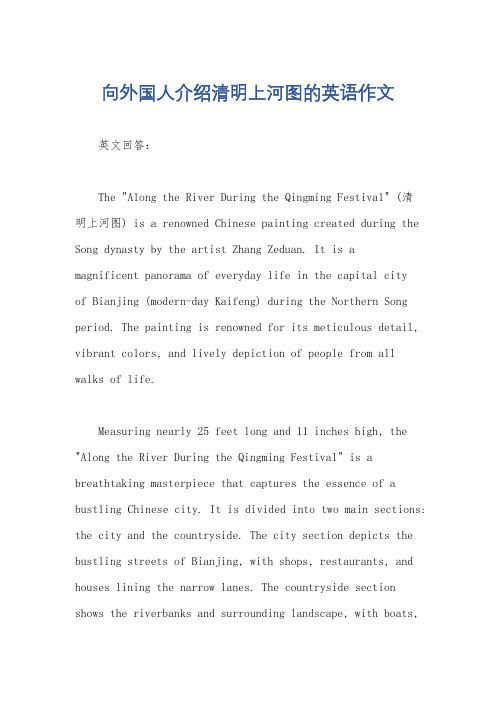
向外国人介绍清明上河图的英语作文英文回答:The "Along the River During the Qingming Festival" (清明上河图) is a renowned Chinese painting created during the Song dynasty by the artist Zhang Zeduan. It is amagnificent panorama of everyday life in the capital cityof Bianjing (modern-day Kaifeng) during the Northern Song period. The painting is renowned for its meticulous detail, vibrant colors, and lively depiction of people from all walks of life.Measuring nearly 25 feet long and 11 inches high, the "Along the River During the Qingming Festival" is a breathtaking masterpiece that captures the essence of a bustling Chinese city. It is divided into two main sections: the city and the countryside. The city section depicts the bustling streets of Bianjing, with shops, restaurants, and houses lining the narrow lanes. The countryside section shows the riverbanks and surrounding landscape, with boats,bridges, and people engaged in various activities.The painting is a treasure trove of historical and cultural information. It provides a glimpse into the daily life, customs, and traditions of the Song dynasty. The clothing, hairstyles, and architecture depicted in the painting offer valuable insights into the lives of ordinary people during that era. The painting also reflects the economic prosperity and artistic sophistication of the Song dynasty, which was a golden age of Chinese civilization.The "Along the River During the Qingming Festival" has been studied and admired for centuries by scholars, artists, and historians. It has been reproduced and copied countless times, and its influence can be seen in later Chinese painting. The painting is a testament to the enduring power of art to capture and preserve a moment in time. It is a national treasure of China and a masterpiece of world art.中文回答:《清明上河图》。
清明上河图高中英语作文
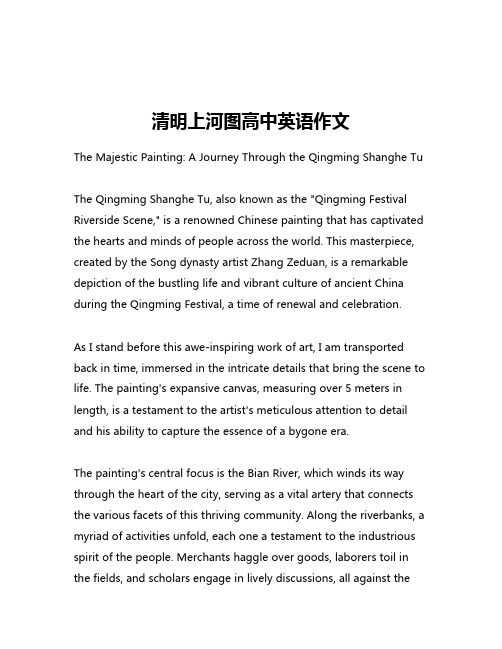
清明上河图高中英语作文The Majestic Painting: A Journey Through the Qingming Shanghe TuThe Qingming Shanghe Tu, also known as the "Qingming Festival Riverside Scene," is a renowned Chinese painting that has captivated the hearts and minds of people across the world. This masterpiece, created by the Song dynasty artist Zhang Zeduan, is a remarkable depiction of the bustling life and vibrant culture of ancient China during the Qingming Festival, a time of renewal and celebration.As I stand before this awe-inspiring work of art, I am transported back in time, immersed in the intricate details that bring the scene to life. The painting's expansive canvas, measuring over 5 meters in length, is a testament to the artist's meticulous attention to detail and his ability to capture the essence of a bygone era.The painting's central focus is the Bian River, which winds its way through the heart of the city, serving as a vital artery that connects the various facets of this thriving community. Along the riverbanks, a myriad of activities unfold, each one a testament to the industrious spirit of the people. Merchants haggle over goods, laborers toil in the fields, and scholars engage in lively discussions, all against thebackdrop of the bustling city.One of the most striking features of the Qingming Shanghe Tu is the sheer diversity of characters and scenes it portrays. From the wealthy aristocrats strolling along the riverfront to the humble street vendors peddling their wares, the painting offers a comprehensive glimpse into the social tapestry of ancient China. The attention to detail is truly remarkable, with each individual figure and object meticulously rendered, capturing the essence of their respective roles and contributions to the overall narrative.As I delve deeper into the painting, I am captivated by the intricate interplay of light and shadow, the delicate brushstrokes that bring the landscape to life, and the harmonious balance between the natural and the man-made. The artist's mastery of perspective and proportion is evident in the way he seamlessly integrates the various elements of the scene, creating a sense of depth and dimension that draws the viewer in.The Qingming Shanghe Tu is not merely a work of art; it is a cultural and historical treasure that offers a window into the past. Through its rich tapestry of images and symbols, the painting provides a glimpse into the social, economic, and political realities of the Song dynasty, a time of great prosperity and cultural refinement.As I study the painting, I am struck by the timeless quality of the scenes it depicts. The bustling markets, the tranquil riverbanks, and the intricate architecture all seem to transcend the boundaries of time, reminding us of the enduring human experiences that have shaped the course of history.In many ways, the Qingming Shanghe Tu is a testament to the resilience and adaptability of the human spirit. Despite the passage of centuries, the painting continues to captivate and inspire, reminding us of the enduring power of art to connect us to our shared past and to illuminate the complexities of the human experience.As I prepare to leave this magnificent work of art, I am filled with a sense of awe and gratitude. The Qingming Shanghe Tu has not only enriched my understanding of Chinese history and culture but has also sparked within me a deeper appreciation for the transformative power of art. It is a masterpiece that will continue to captivate and inspire generations to come, a timeless testament to the enduring spirit of the human experience.。
- 1、下载文档前请自行甄别文档内容的完整性,平台不提供额外的编辑、内容补充、找答案等附加服务。
- 2、"仅部分预览"的文档,不可在线预览部分如存在完整性等问题,可反馈申请退款(可完整预览的文档不适用该条件!)。
- 3、如文档侵犯您的权益,请联系客服反馈,我们会尽快为您处理(人工客服工作时间:9:00-18:30)。
Features of the Song original
• In the 5.28-meter long picture, there are 814 humans, 28 boats, 60 animals, 30 buildings, 20 vehicles, nine sedan chairs, and 170 trees drawn.The countryside and the densely populated city are the two main sections in the picture, with the river meandering through the entire length.
Section of the painting on the far right, showing travelers amidst a wooded countryside
A scene of boats docking along the side of the river and urban sprawl approaching the main gate of the city
• From January 2–24, 2012, the painting was exhibited in the Tokyo National Museum as the centerpiece of a special exhibition to mark the 40th anniversary of normalized diplomatic relations between China and Japan, with the Japanese museum officials providing the "highest security standards" for the work
The main gate of the city and the urban setting within, with teahouses, vendors, homes, and various figures interacting with one another
Hosting
• In a rare move, the Song original was exhibited in Hong Kong from 29 June to mid-August 2007 to commemorate the 10th anniversary of Hong Kong's transfer to the People's Republic of China. It is estimated that the costs of shipping the painting have run into the millions of Hong Kong dollars in addition to the cost of insuring this piece of priceless art, which is estimated to be in the tens of millions of Hong Kong dollars.
The bridge scene where the crew of an oncoming boat have not yet fully lowered their sails and are in danger of crashing into the bridge
Scene of urban sprawl right before the bridge leading to the main gate of the city
• Similar to the Mona Lisa, the Qingming scroll was sold, changing hands among numerous private owners, before it finally returned to public ownership. The Qingming scroll is notable historically as being among the paintings from the former imperial collection that remain in public ownership in mainland China; it was a particular favorite of emperor Puyi, who took it with him to Manchukuo and thus kept the Song Dynasty original out of the collection of the National Palace Museum. It was later re-purchased in 1945 and kept at the Palace Museum in the Forbidden City.
• About 20 to 30 variations on this topic by artists of subsequent dynasties were made. Several Ming and Qing versions can be found in public and private collections around the world. Each version follows the overall composition of the original fairly faithfully, however, the details often vary widely. The Song Dynasty original and the Qing version, in the Beijing and Taipei Palace Museums respectively, are regarded as national treasures and are exhibited only for brief periods every few years. For instance, the wait in Beijing to see the painting was three and a half hours.
•
• 蜀錦裝金壁 • 吳工聚碎金 • 謳歌萬井富 • 城闕九重深 • 盛事誠觀止 • 遺踪借探尋 • 當時誇豫大 • 此日歎徽欽
Associated poem
A wall of gold has been mounted on Shu brocade. Craftsmen from Wu collect spare change. To pay tribute to the abundance of a myriad of families. The watchtowers of the city rise to great heights. The bustling scene is truly impressive. It is a chance to explore vestiges of bygone days. At that time, people marveled at the size of Yu, And now, we lament the fates of Hui and Qin.
Along the River During the Qingming Festival
• Along the River During the Qingming Festival is a panoramic painting generally attributed to the Song Dynasty artist Zhang Zeduan. It captures the daily life of people from the Song period at the capital, Bianjing, today's Kaifeng. The theme celebrates the festive spirit and worldly commotion at the Qingming Festival, rather than the holiday's ceremonial aspects, such as tomb sweeping and prayers. The entire piece was painted in hand scroll format and the content reveals the lifestyle of all levels of the society from rich to poor as well as different economic activities in rural areas and the city. As an artistic creation, the piece has been revered and court artists of subsequent dynasties have made several re-interpretive replicas. The painting is also known for its geometrically accurate images of boats, bridges, shops, and scenery. Because of its fame, it has been called "China's Mona Lisa".
